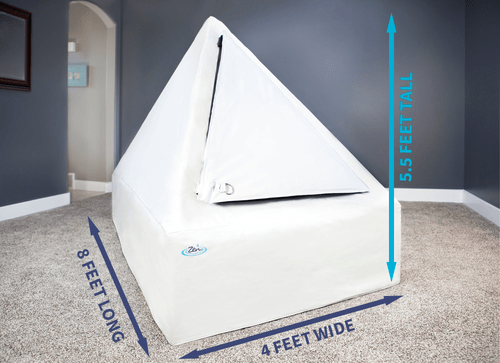When I first heard the term sensory deprivation on the radio, I thought that it was some kind of a stylish method of torture that one can see in the old war movies.
Well, it turned out that I was partially right.
In 2007 the convicted terrorist José Padilla experienced the horrifying effects of being locked in a small cell for days with lack of sound and light.
 The purpose of that was to break him in order to uncover important information about a deadly terrorist organization.
The purpose of that was to break him in order to uncover important information about a deadly terrorist organization.
This had devastating consequences for his psychological but also physical condition. After released from the cell, Padilla showed signs of a complete disorientation and he suffered from tremors, facial tics, and hallucinations. He was a mess.
No, my purpose is not to scare you but rather to stress that the sensory deprivation could indeed have destructive effects on one’s body and mind if it is practiced constantly for days.
But conventionally, the sensory deprivation is a proven way of enhancing the health and stimulating one’s well-being by the means of the floatation therapy.
In the following paragraphs, I’m going to describe the most important things that you should know as a beginner for this highly popular method of relaxation and health care.
What is a Floatation Therapy?
Why it is floatation and why it is a therapy, you’ll ask.
In its essence, it represents the act of seamlessly floating in a special tank full of 10 inches of water, heated to a body temperature.
Usually, the tank also called an isolation capsule is sound proof and inside it is pitch black dark.
However, there are some tanks that have the option to play some chill out music via underwater headphones and the possibility to turn on tender nuances of light.
The floating itself happens thanks to the presence of 800-1000 lbs of Epsom salt (Magnesium Sulfate) in the water which prevents the body from sinking.
In that way, there is a gravity-free and sensory reduced environment that allows the complete relaxation of the muscles.
Think of it as the floating in space that the astronauts experience.
Why is it so modern?
Besides being extremely healthy and more and more people share their excitement every day, the floating hype continues to grow thanks to the celebrities who popularize it.
 The keenest adherent of the sensory deprivation is probably the comedian and UFC commentator Joe Rogan.
The keenest adherent of the sensory deprivation is probably the comedian and UFC commentator Joe Rogan.
According to him, the floatation therapy is the most powerful tool for developing the mind, thinking, and evolving.
Joe shares that spending an hour in the tank every day makes him more relaxed, energetic, and confident.
Some of the other celebrities that are die-hard fans of the floating therapy are Russell Brand, Jeff Bridges, Elle Macpherson, Carl Lewis, and Wayne Rooney.
The Healthy Perks of Floating
The floatation therapy is a natural way of healing compared to the dominating chemical-based treatments.
There are numerous scientific studies that prove that the sensory deprivation and especially the floatation therapy have amazing effects on one’s body and mind.
Thousands of people swear that floating changed their life for the better.
It is true that this health and wellness tool has a plethora of benefits.
 The most important advantage of the sensory deprivation is the fact that it significantly reduces stress.
The most important advantage of the sensory deprivation is the fact that it significantly reduces stress.
As we know, the stress is the main reason behind many physical and mental illnesses and it has devastating effects on our health.
It is a physical response that travels throughout our entire body causing disorder and destruction, thus making our cells and organs suffer.
Now, with the following statistics, I admit that I want to scare you and alert you to just some of the negatives that the stress provokes:
- 1 in 5 Americans experience extreme stress that leads to shaking, heart palpitations, and depression
- Stress increases the risk of heart disease by 40%, the risk of heart attack by 25%, and the risk of stroke by 50%.
- The stress is the basic cause of 60% of all human physical and mental illness and disease.
I think that it is needless to say that reducing the stress is crucial for preserving our health.
Here comes the invigorating floatation therapy that can do miracles when it comes to decreasing the levels of stress.
Unlike any other method of relaxation, the idea of the sensory deprivation is to entirely prevent your mind and body from processing any kind of external stimuli, thus ensuring a full composure.

Most probably you will be surprised to learn that no matter if you are lying on a couch or sleeping on your comfortable beach mattress, your body still doesn’t relax at 100%.
This is because the mind is still exposed to sensory stimuli such as light, noise, and even the touch of your body on the surface of your bed.
All that makes the brain work by sending various signals to the body, which creates tension, even though we don’t realize it. And we don’t simply because we are so used to it.
In that train of thought, there is nothing more relaxing than floating into the nothingness without any sound and in a complete darkness.
Some of the proven benefits of the floatation therapy are:
- It induces deep relaxation of the mind and the muscles. That is why many athletes are enjoying it.
- Floating provokes theta waves in our brains. We usually experience this state just before sleep or shortly after starting to awaken. This is the phase when our brain is in its most relaxed and peaceful condition. The Buddhist monks strive to achieve this mental state through deep meditation.
- Floating is conducive to meditation.
- It helps reducing pain
- It lowers blood pressure
- It helps in battling the Bodily Distress Syndrome
- It lowers cortisol levels
- It lowers chronic fatigue syndrome
- It boosts creativity
The Epsom salt itself also has its amazing perks because it absorbs through the skin:
- Relieves muscle tension and abdominal cramps
- Heals headache
- Heals tired and sore feet
- The magnesium sulfate stimulates the enzymatic functions
- Regulates the blood retention in the cells
- Enhances the arterial health and the blood circulation
- Improves the cardiovascular health
- Regulates the blood sugar
- Reduces inflammation around wounds
- It exfoliates the skin by removing dead cells.
Like you see, the list of the beneficial effects of the floating is long. However, do note that this is just a small fraction of it.
Where to Float?
The most popular place where one can float is at the floating spa center.
There are welness centers that offer exclusively sensory deprivation services but with the increasing demand for floating, now every regular spa center tends to invest in a floatation tank.
 You can search online for local float spa centers near you by typing ‘float spa near me’.
You can search online for local float spa centers near you by typing ‘float spa near me’.
You will have to book in advance because of the constantly busy schedules in the centers.
What I’d recommend is to check out the amazing new opportunity to float at home (tyka slagam linka kam reviewto) because it can save a lot of time and money.
The Costs of Floating
Usually, you will pay between $50 and $70 for one hour of floating at the local spa center.
A monthly membership card that allows four one-hour float sessions will cost you approximately $180.
Types of Floatation Tanks
The first sensory deprivation tank was invented in 1954 by the American neuroscientist Dr. John C. Lilly.
It was part of his research for the National Institute of Mental Health.
There are several kinds of floatation tanks:
Pods
They are also called isopods. This is the most common sensory deprivation tank. It is also the most sophisticated one with its various components, ultra-modern 24-hour filtration technologies, and many comfort-oriented options.
It looks like a futuristic sleeping capsule from Star Trek, where everything is programmable.
 It is a private chamber in the form of an egg, made from high-quality glass reinforced plastic.
It is a private chamber in the form of an egg, made from high-quality glass reinforced plastic.
It has modern filtration and heating system
Normally, it is 8.5 feet long, 5.5 feet wide, and its height is around 4.2 feet.
Often, an isopod allows the possibility to connect your smartphone via Bluetooth and to listen to music while floating. Also, there is a built-in Mp3 player.
These tanks are also equipped with LED lamps and the light can be easily adjusted from the floater.
For your information, the price of such a tank starts from $15 000 depending on its features. There are also isopods that cost $45 000.
Float Rooms
For those suffering from claustrophobia, this can be the better choice.

Unlike the isopod, the float room is an open space without doors and it allows collective floating which can be excellent if you want to float with your friend, for example.
In other words, it has many of the components of the pods but it is more like a bathtub with the size of a double bed.
Cabin Tanks
The name is rather descriptive. These tanks resemble a regular bath cabin that is built into walls and it is accessible through a door.

You can easily step in, lay back, and float.
Rectangular Float Tank
This is the oldest, old-school form of a floatation tank. They are also the most claustrophobic ones because they are not as large as the others.

Often, the roof can slide so that one can enter into it. In other cases, the entrance is provided via a hatch.
The Zen Float Tent
This is a revolutionary example of a creative thinking, turned into a wonderful product that eliminates the often annoying and expensive visits to the float spa center.
The Zen float tent is a tank intended for home use that can easily fit in any room.
 It offers unparalleled comfort and with its price starting from $1940, it makes a rather affordable solution for everyone who is serious about floating.
It offers unparalleled comfort and with its price starting from $1940, it makes a rather affordable solution for everyone who is serious about floating.
The tank is in the form of a tent and it can be easily assembled in less than an hour.
It has a well-thought-out filtration and heating system that allow uncomplicated maintenance.
If you want to find out more about it, read my unbiased review of the Zen Float Tent.
What should you know before your first floating session?
Like anything new, floating for the first time can be very exciting.
In order to make it even better, I will share with you some tips and best practices that can help you in making your first float a really positive experience.
Remember that floating becomes better the more you do it.
- It is mandatory to book your session in advance if you are not using the zen float tent and you are not floating at home.
- In the spa center, the floating tank is in a separate room where you have a place to change and to take a shower before and after your floating session.
- It is recommended to float wearing your beach outfit. It is OK to be completely naked as well.
- Taking a shower before the floating session can relax you and prepare your body for the shortly upcoming dive into the nothingness.
- Make sure not to wear any perfume, hair gel, makeup or anything that may dissolve in the water.
- If you float in a spa center you will usually receive a float kit that contains ear plugs. It is recommended to use them in order to cut out the noise and to prevent the water from entering in your ears.
- If the filter in the tank is running, you can ask the staff to turn it off. This will eliminate the noise.
- Don’t forget that the water is full of salt. Keep that in mind if you have even small cut wounds because once the salt makes contact with your blood, you will start screaming. To avoid that, use Vaseline on the wounds and the water won’t go there.
- Once in the tank, take a small towel with you inside in case the salt accidentally enters in your eyes.
- Position yourself comfortably and avoid any movement after that.
- If you are claustrophobic and you are floating in a tank, you can always leave it ajar.
- In the beginning, you may feel like your mind is speeding and you will have difficulties relaxing. Don’t worry. It is normal. It takes time. After the first fifteen minutes, you will start to feel more and more comfortable with yourself and you will find that your tight muscles loosen up and your mind slows down in an impressive ease until it enters into a blissful state.
- If you start to freak out because of the pitch darkness inside the tank you can turn on and adjust the light.
- If this will make your session more pleasant, don’t hesitate to listen to music while floating.
- If you are floating at the spa and not in home, once your time is off, there will be a soft music inside the tank alerting you that the session ends.
- After the float, take a shower too in order to wash away the salt.
- Use a hair lotion because the salt exhausts the hair.
FAQ
You ask, we answer.
Is it safe in the floating tank?
Yes, it is completely safe and you can’t drown simply because there are only 10 inches of water that are full of salt that makes you float on the surface.
Wait, I am claustrophobic! What Should I do?
You can always leave the tank door ajar or float in a floating room instead of being in a tank.
How long should I float?
You can float as long as you wish by keeping in mind the costs of floating. Usually, most of the people float at least once per week for 1h or 1h30min. If you don’t mind the costs or if you own a home floatation tank, you can do it every day.
Is it hygienic to float in a spa center?
Absolutely. The tanks have advanced filtration systems that ensure an always clean and health-friendly environment.
Can I float with a friend?
Yes. That is possible when you float in a floatation room or in a float cabin that has enough space.
I want to float more often that can I afford and I do not like going to the spa. What should I do?
You better seriously consider purchasing a home floatation tank. It will save you time and money.
Should I do it if I suffer from epilepsy?
Absolutely not. Consult your doctor first.
Feel free to leave a comment or to contact us if you have any other questions or inquiries. I will be happy to chat with you! Thank you for reading and don’t hesitate to make the leap and start floating today!




What an educational post! As someone who has actively meditated for 20 years I totally get the idea of sensory deprivation. My hubbie and I have experimented with float tanks over the years. The sensation of complete darkness can be overwhelming at first, but once you give in and start to focus on consistent slow breathing the fear sensation goes away. This is then followed by a beautiful, calm quiet state. We both found that we were able to carry that calm, wordless state into our days.
Hi Stacy,
I am happy to learn that you like my post.
It is also good to meet someone wit sch a rich floatation experience like you.
This is amazing. There is a saying from where I come from, “Water Heals Everything”. I am convinced in the truth behind it because I enjoy swimming from time to time. The feeling of calmness and mindfulness after 30 mins in water is priceless. Also, I practice meditation every day. I found it very beneficial for my overall health. Now, this is something different! This is next level! I can’t wait to try. Thanks for sharing. All the best,
Ivan
Hello Ivan,
From where I come from, they also say that the water heals everything. It has to be true because the water is a powerful energy.
The sensory deprivation and the floatation therapy combine the beneficial effects of water full of Epsom Salt with the calmness of being deprived of any external stimuli. The effect is unparalleled. If you practive meditation, then you will certainly like this popular method of well-being.
This is the first time I am hearing about this as some kind of therapy. I remember when I was a kid I used to go to the beach with friends and we used to make float competitions for fun but eventually, we stopped doing it. You mentioned that the best place to float in the spa. I imagine it’s because the amount of water you need to float to have a successful therapy is minimal? And that is why doing it at the beach is not convenient?
It is also the first time I hear about Epson salt: is there a particular brand that works best and where can I find it?
Oh! I’m mesmerized by all the kind of floatations thanks. Looking at the luxurious designs I don’t think these will be available in the common spa. But they look familiar, I think I saw the float roam in a Korean Movie I don’t remember which one anymore.
I have to admit I was a little scared of your introduction but by now I am interested in learning more about this. Thanks for sharing!
Hello Dira,
To answer your question – it is not possible to perform sensory deprivation at the beach since it is too noisy and there is light.
The idea of the sensory deprivation and more specifically of the floatation therapy is to totally unplug yourself from the external world, thus excluding any kind of external stimuli. In that way, the brain and the body can relax at maximum.
Hi
I absolutely need that in my home 🙂 Need to improve my online business results first. Thanks again for your hot seat participation.
All the best in your business
Cheers, Jeff
Hi Jeff,
As I am digging deep into the world of the sensory deprivation I become more and more certain that everyone should have such tent. I really hope that one day you will have one too.
Take care and I wish you all the best with your online business!